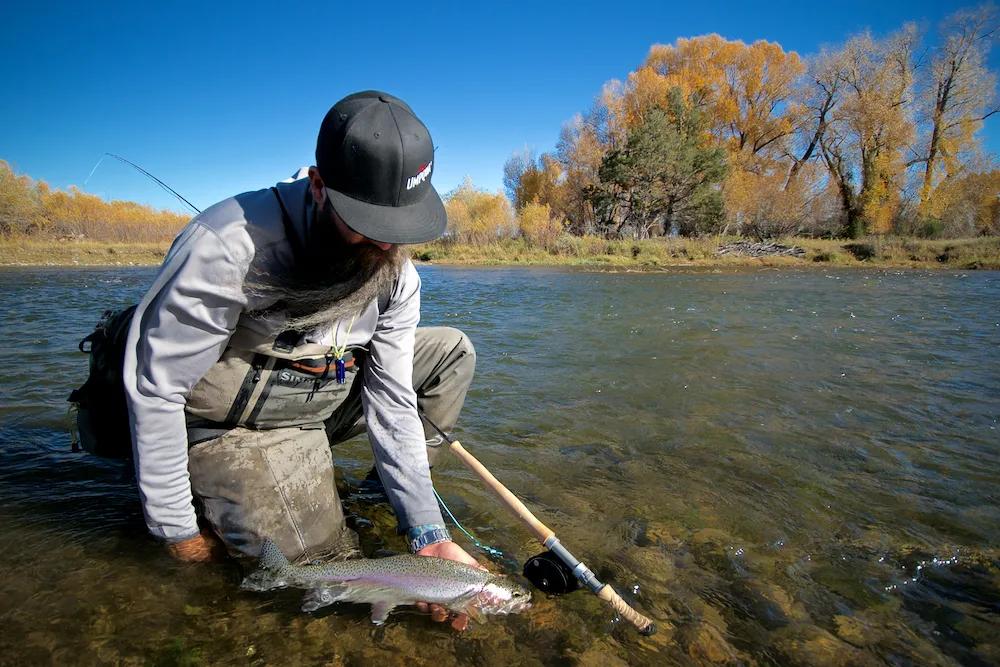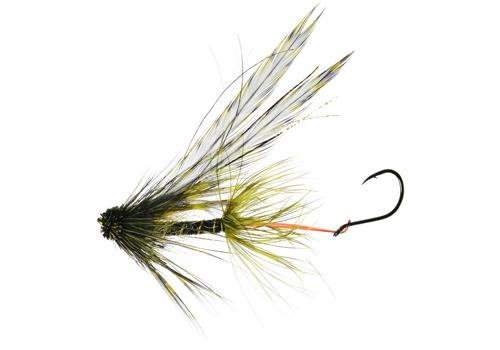
A fun and effective method of trout fishing is the down-and-across streamer swing. The popularity of trout spey fishing in Montana has grown exponentially over the last few years and for good reason. The simplicity of spending a day stepping down a run casting and swinging is a refreshing change from the usual day of trout fishing. Not to mention the take or “grab” while swinging is pretty exciting. The down and across presentation is done under tension, while passively swinging their fly through likely holding water, often daydreaming or enjoying the scenery. Then out of the blue a trout will aggressively grab the fly, sometimes startling the angler! Most of our staff and guides at Montana Angler are experienced spey fishermen and spend our fair share of time fishing our Southwest Montana rivers with a two-handed rod, let us set up a day of fishing that includes swinging flies with a spey rod for trout.
As trout anglers, we tend towards bringing everything but the kitchen sink when it comes to fly selection and accessories. Trout spey fishing is a great change because you can leave all the extras at home and just head out with your rod, a sink tip or two, some leader material, and a small assortment of spey flies.
Today’s trout spey post focuses on selecting effective flies for casting and swinging with a light trout spey rod.
What makes for a good trout swing fly?

Grillos’ Captain Crunch is an excellent example of a trout spey fly.
Good trout spey flies can vary from small soft hackles, to more traditional streamers, up to larger flies that parallel winter steelhead flies like intruders and prom dresses. Depending on the conditions and the chosen equipment for the day one particular style of fly may be more advantageous. The most important consideration other than if the fish will be interested in the fly, is whether or not the angler can effectively present said fly through fishy water. Just as you wouldn’t expect to cast an XL articulated streamer on your light dry fly rod, you shouldn’t expect to cast large swing flies on a small, trout spey rod. Matching your fly to the rod is key to the day’s casting success.
Soft hackles: Fishing soft hackles can be very fun and effective when there is some sort of insect activity. One example of a great time to swing soft hackles is early on during a caddis hatch. Caddis tend to make a mad dash for the surface and trout can get keyed in on chasing the caddis that are quickly moving through the water column. A few of our favorite soft hackles are shown below. They all have a similar profile in the water, a long webby hackle that moves and pulsates while swinging the fly, and 2 of the 3 have a little tungsten bead that helps keep the fly down in the water column. A soft hackle with a little bit of flash in the fly will stand out while swinging across the current as well.
Another nice thing about swinging soft hackles is that the small flies can be effectively cast on the smallest and lightest of spey rods. These are perfectly suited to casting on the new generation of “micro-spey” rods that have become popular in the last couple years. These smaller, ultra light spey rods don’t have the backbone to cast a big fly and a heavy sink tip, however they are perfect for casting small flies on lighter tips. A longer leader and a full-floating “dryline” can even be employed while fishing these soft hackles, allowing the angler to swing the flies just under the surface. The light rods also make for a very fun fight when hooked up.

| 
| 
|
Streamers: Again, one of the first considerations when selecting a streamer for swing fishing is the castability of the pattern. When choosing streamers for swinging, lighter flies are more favorable, allowing your sink tip to drop the fly down in the water column rather than a heavy fly with a large conehead or large lead eyes. Similarly, flies that maintain their profile in the water without being too bulky are great choices. Bulky flies may be effective for the short casting and stripping method of streamer fishing from a boat, however flies that “fish big, but cast small” are more ideal for swinging as they’ll drop more quickly in the water column and will maintain their depth while swinging under tension. Look for more flowy flies tied with materials that won’t soak up a lot of water. This will make them easier to cast and gives the fly more movement in the water. Many standard streamers in your fly selection will work well as long as they aren’t too heavy or bulky.

| 
| 
|
Trout spey specific flies: As fishing for trout with spey rods has become more and more popular, specific flies have been developed that lend themselves to swing fishing for trout. These patterns tend to borrow design elements from steelhead flies, such as stinger hooks, light overall weight, and longer flowy materials that give the fly an illusion of being larger without actually being large and bulky flies. Typically, flashy materials are good additions to trout spey flies as well, adding a bit of flash is yet another trigger that will hopefully get a curious trout to pursue and strike your fly. You’ll also note that effective trout spey flies are tied relatively sparsely as sparse flies will drop quickly in the water column and will hold their depth while under tension. A few very effective trout spey specific flies are shown below:

| 
| 
|
Experience Montana’s world-class trout fishing from a new angle!
Many of Montana Angler’s guides are experienced spey fishermen and would love the opportunity to share their knowledge of swinging flies for trout with you. Shoot us an email or give us a call at 406-522-9854 to set up a day of spey fishing for trout with one of our guides here in Southwest Montana!

